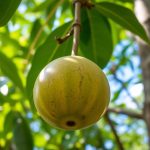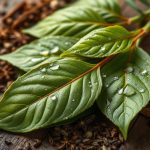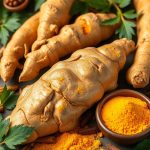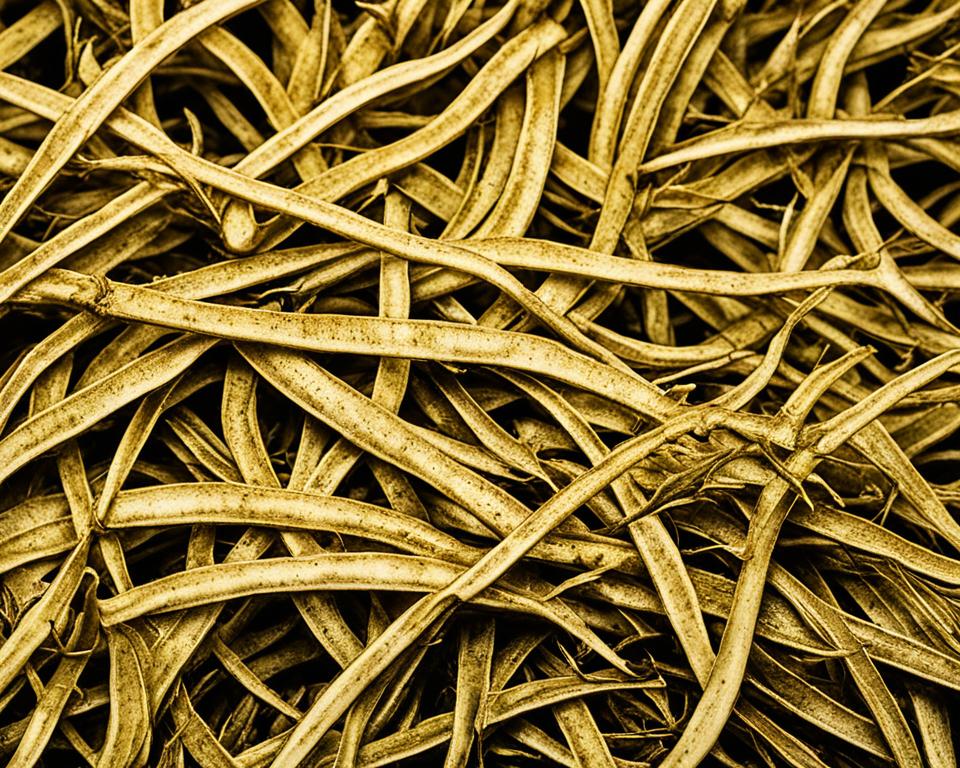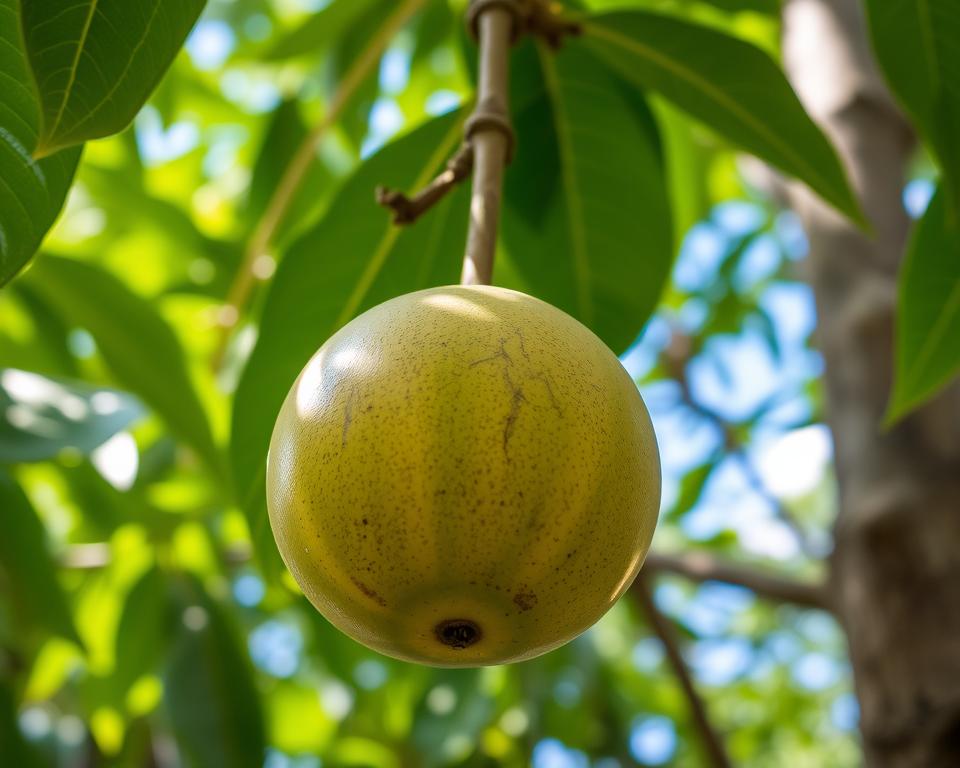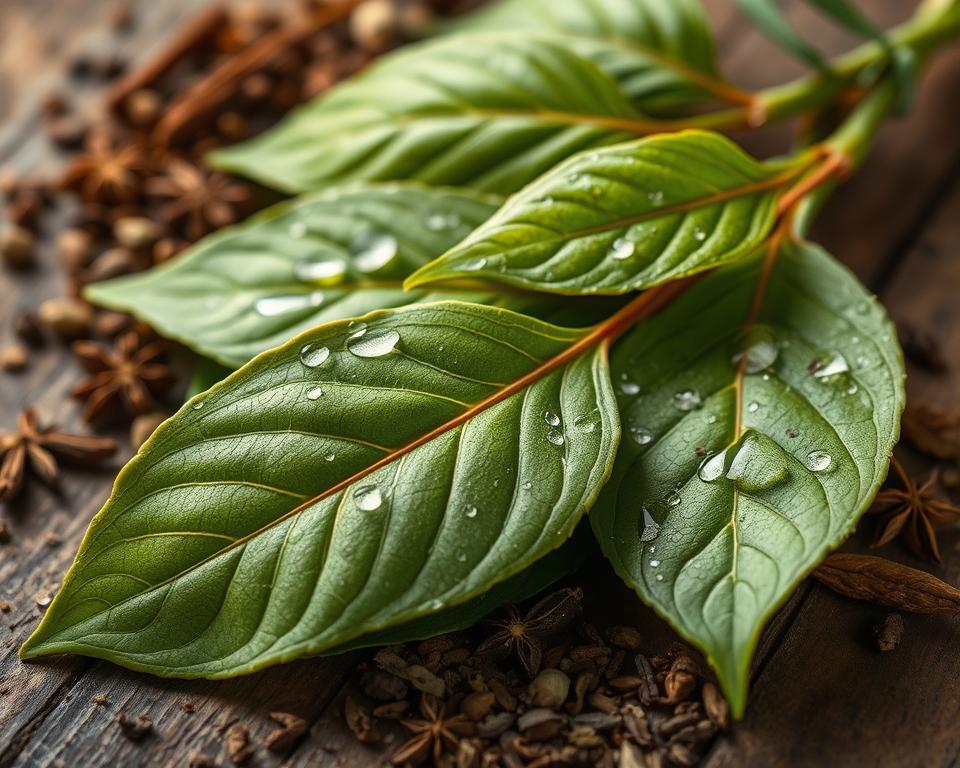Ginger is a spice known for its unique taste and health perks. It has a scientific name that shows where it comes from. Zingiber officinale Roscoe, or ginger, is important in cooking and traditional medicine worldwide. This piece will explore ginger’s scientific name, its plant features, and the many nutrients in its root.
Read interesting things at : tosawakan
Key Takeaways
- Zingiber officinale Roscoe is the scientific name for the ginger plant.
- Ginger has a long history of traditional and medicinal use across various cultures.
- The ginger rhizome is rich in bioactive compounds like gingerols and shogaols, which contribute to its health benefits.
- Ginger is widely used in both savory and sweet culinary applications.
- Ginger possesses anti-inflammatory and antioxidant properties that have been studied for their potential health benefits.
Introduction to Zingiber Officinale Roscoe
The scientific name for the ginger plant, Zingiber officinale Roscoe, is deeply rooted in history and culture. It belongs to the Zingiberaceae family. The name “Zingiber” comes from the Sanskrit word “śṛṅgavera,” meaning “horn-shaped.” This refers to the plant’s unique rhizome shape.
The Scientific Nomenclature of Ginger
The name “officinale” means the plant is used as an herbal remedy and food ingredient. “Roscoe” honors William Roscoe, a British botanist who helped classify this plant.
Historical Use of Ginger across Cultures
Zingiber officinale Roscoe, or ginger, has been valued for thousands of years. It comes from ancient traditions in Ayurvedic, Chinese, and Middle Eastern cultures. People used it for its flavor and health benefits.
| Culture | Historical Use of Ginger |
|---|---|
| Ayurvedic Medicine | Ginger is key in Ayurvedic healing, treating many health issues, like digestive and respiratory problems. |
| Chinese Medicine | In Chinese medicine, ginger helps improve blood flow and treats various health issues. |
| Middle Eastern Cuisine | Ginger is a main ingredient in Middle Eastern food, adding warmth and flavor to dishes. |
Zingiber officinale Roscoe, or ginger, has a long history and cultural importance. This has made it popular and widely used around the world.
Botanical Characteristics of Zingiber Officinale Roscoe
The Zingiber officinale Roscoe, also known as ginger, is a tall, perennial herb. It can grow up to 1 meter tall. This plant stands out with its large, green leaves and bright yellow-green flowers. But, its real value is in its underground rhizome, or ginger root, which has been prized for centuries.
Morphological Features of the Ginger Plant
The Zingiber officinale Roscoe plant has interesting features. Its leaves are big, green, and shaped like lances. The plant also has yellow-green flowers that make it stand out. But, its most valuable part is the ginger root from its underground rhizome.
The ginger rhizome is made up of many connected segments branching from the stem. These segments have scaly rings, giving the rhizome its look. The rhizome also has small roots that help the plant get nutrients from the soil.
| Characteristic | Description |
|---|---|
| Height | Up to 1 meter |
| Leaves | Large, green, lance-shaped |
| Flowers | Yellow-green |
| Rhizome | Underground, branching network with scaly rings and fibrous roots |
The Zingiber officinale Roscoe plant shows the beauty of nature. It has both above-ground and underground parts that have amazed people for ages. Its leaves and flowers are beautiful. And the ginger rhizome is a key ingredient in many foods and medicines worldwide.
Zingiber Officinale Roscoe: The Rhizome
The rhizome, or underground stem, of Zingiber officinale Roscoe is key for its health and food uses. It has a strong smell that comes from bioactive compounds. These compounds are what make ginger so good for us.
The ginger root, or rhizome, is a key ingredient in many dishes and medicines. For centuries, it has been used in different cultures. It’s known for its spice flavor and its long history in traditional medicine.
The Zingiber officinale Roscoe rhizome looks unique with its knotty and yellow-orange look. It’s where the plant stores its important compounds. These compounds give ginger its smell, taste, and healing powers.
| Characteristic | Description |
|---|---|
| Appearance | Knotty, segmented, and yellow-orange in color |
| Aroma | Distinct, pungent, and aromatic |
| Composition | Rich in bioactive compounds, including gingerols, shogaols, and zingerone |
| Uses | Culinary, medicinal, and traditional applications |
The rhizome of Zingiber officinale Roscoe is a key part of ginger. It’s full of uses in cooking and medicine. People all over the world have been drawn to its benefits for centuries.
Phytochemical Composition of Ginger Root
Zingiber officinale Roscoe, also known as ginger, is a special root. It has a rich mix of bioactive compounds. These make it both tasty and useful for health.
Bioactive Compounds in Ginger
The strong taste of ginger root comes from compounds like gingerol, shogaol, and zingeron. These phytochemicals give ginger its unique flavor and aroma. They also help with inflammation and fighting free radicals.
Nutritional Profile of Ginger
Ginger root is packed with vitamins, minerals, and antioxidants. These nutrients are good for your health. The mix of nutrients in Zingiber officinale Roscoe makes it great for cooking and medicine.
“Ginger’s phytochemical profile is a testament to its versatility as both a culinary and medicinal powerhouse.”
Traditional and Modern Uses of Ginger
Zingiber officinale Roscoe, also known as ginger, has been a key ingredient in traditional medicine and food for centuries. This amazing root has become a staple in the kitchens and healing traditions of many cultures worldwide. Its versatility and lasting appeal are clear.
In traditional medicine, ginger is highly valued for its healing properties. The zingiber officinale roscoe plant helps with inflammation, digestion, and breathing. It’s a top choice for treating many health issues. In ancient Ayurvedic and traditional Chinese medicine, ginger is used in teas, tonics, and tinctures.
Ginger root is also a big deal in the kitchen. It adds a unique flavor to many dishes, from savory meals to sweet treats. Its taste and smell are key parts of many global cuisines.
| Traditional Uses of Ginger | Modern Culinary Applications of Ginger |
|---|---|
|
|
Ginger‘s lasting popularity shows its wide range of uses. It enriches our lives in both old and new ways. By looking into its history and uses, we see why this zingiber officinale roscoe is so special.
Health Benefits of Zingiber Officinale Roscoe
Zingiber officinale Roscoe, also known as ginger, is highly valued for its health perks. This root comes from Asia and has been studied a lot. It’s full of anti-inflammatory and antioxidant stuff.
Anti-inflammatory Properties of Ginger
Zingiber officinale roscoe has compounds like gingerol and shogaol that fight inflammation. These substances stop the production of things that cause inflammation. This helps with conditions like arthritis, muscle pain, and cramps.
Antioxidant Effects of Ginger
Zingiber officinale roscoe is also great at fighting off free radicals with its antioxidants. It has compounds like gingerol, shogaol, and zingerone that protect cells. This can help prevent heart disease, cancer, and other health issues.
“Ginger has been used for centuries in traditional medicine to treat a wide range of ailments, and modern research is now validating its remarkable therapeutic potential.”
Adding ginger to your diet or supplements can boost your health and wellness.
Culinary Applications of Ginger Root
The versatile zingiber officinale roscoe, known as ginger or ginger root, is a key ingredient in many dishes. Its unique taste and smell are perfect for both savory and sweet foods. This makes it a favorite in kitchens everywhere.
Ginger in Savory Dishes
Ginger adds depth and complexity to many savory dishes. It pairs well with garlic, soy sauce, and chili peppers. This makes it essential in Asian-style cooking. It’s used in curries, stir-fries, marinades, and sauces. Ginger root adds a special touch to these dishes.
Ginger in Sweet Treats
Ginger is also great in desserts and baked goods. It’s found in ginger snaps, gingerbread, and gingerbread. This adds a spicy-sweet taste. Plus, it’s used in cakes, cookies, pies, and ice creams. It balances the zingiber officinale roscoe‘s strong flavor with dessert sweetness.
“Ginger is the universal spice. It can be used in savory and sweet dishes, hot or cold beverages, and in a variety of cuisines around the world.”
Cultivation and Harvesting of Ginger
Zingiber officinale Roscoe, known as ginger, grows in warm, humid places all over the world. It’s a key plant for food and medicine. Let’s explore how it’s grown and harvested.
Ginger loves warm weather and moist soil that drains well. Farmers plant small pieces of the ginger root, called rhizomes, which have buds. They make sure the plants get enough water, food, and sunlight for 8-10 months.
When the ginger leaves start to turn brown, it’s time to dig up the rhizomes. This usually happens after 8-10 months. The farmers wash and prepare the ginger for use. Then, it might be peeled, sliced, or dried, depending on what it’s for.
| Ginger Cultivation and Harvesting | Key Considerations |
|---|---|
| Climate | Tropical and subtropical regions |
| Soil Requirements | Well-drained, nutrient-rich |
| Planting | Vegetative propagules (rhizome sections) |
| Growth Cycle | 8-10 months |
| Harvesting | When leaves die back, typically 8-10 months |
| Post-Harvest Processing | Washing, peeling, slicing, drying |
The steps to grow and harvest Zingiber officinale Roscoe, or ginger, are key to getting it to us. We learn about the special needs and steps to see the hard work behind ginger’s journey. From the field to our tables and medicine cabinets, it’s a long process.
Zingiber Officinale Roscoe in Traditional Medicine
Ginger, known as Zingiber officinale Roscoe, has a long history in traditional medicine. It’s especially important in ancient Ayurvedic practices of India. Ayurveda sees ginger as a key part of health and wellness. It values the ginger root’s healing powers.
Ayurvedic Perspectives on Ginger
In Ayurvedic thought, Zingiber officinale Roscoe warms and stimulates the body. It’s often suggested as a herbal remedy for many health issues, such as:
- Digestive problems: Ginger helps with nausea, bloating, and indigestion.
- Respiratory issues: Its expectorant properties help with coughs and congestion.
- Inflammation: Ginger’s anti-inflammatory effects are used for arthritis and muscle pain.
Ginger is also seen as a versatile spice in Ayurvedic medicine. It can be used in food and medicine, making it even more useful.
“Ginger is considered a ‘universal medicine’ in Ayurvedic practice, with a wide range of applications to promote overall health and well-being.”
Zingiber officinale Roscoe’s long history in Ayurvedic medicine shows its deep respect and value. It’s a key part of ancient Indian health traditions.
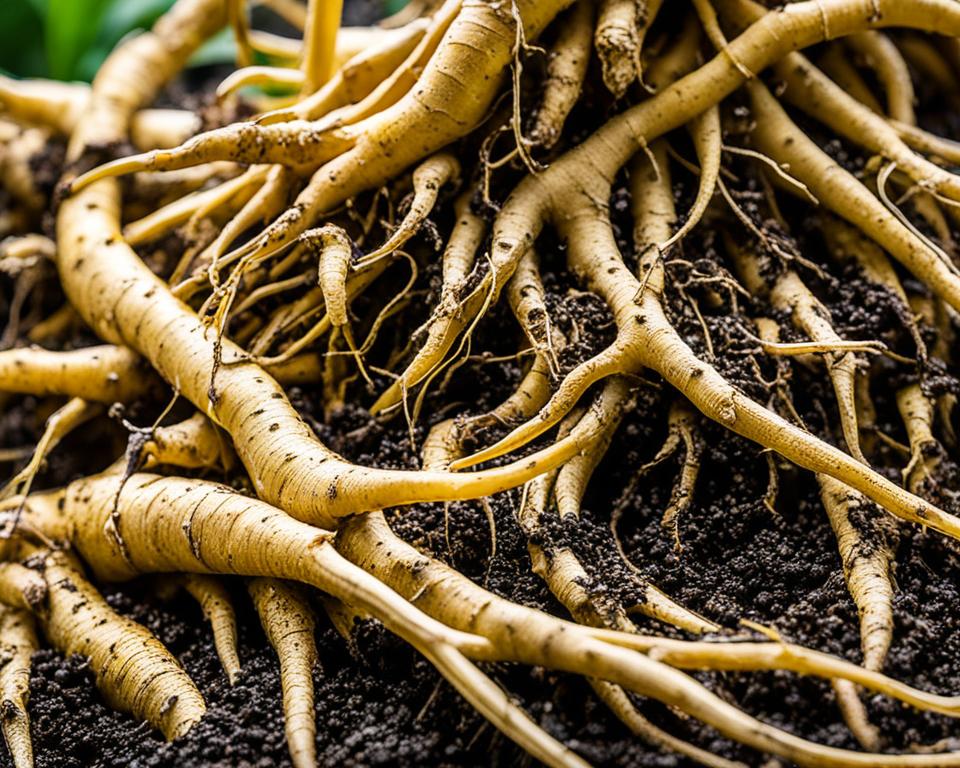
Ginger as a Natural Remedy
Zingiber officinale Roscoe, also known as ginger, is a natural remedy for many health issues. It’s especially good for digestive health. Ginger root contains compounds like gingerol that help with digestion. This makes it a go-to for nausea, indigestion, and bloating.
Ginger for Digestive Health
Studies have shown that ginger is great for the digestive system. The strong taste of ginger root helps make digestive juices. This aids in breaking down and absorbing food better.
Ginger also has anti-inflammatory properties. These can ease stomach irritation and discomfort.
- Ginger is known to ease nausea, like morning sickness and motion sickness.
- Research points to its ability to lessen indigestion symptoms, including bloating, gas, and heartburn.
- Some studies suggest that ginger root can help with gut motility. This might improve bowel function and ease constipation.
Ginger is a versatile natural remedy for digestive health. It’s popular among those looking to boost their wellbeing. Always talk to a healthcare professional before adding ginger to your routine.
Safety and Precautions with Ginger Use
Zingiber officinale roscoe, also known as ginger or ginger root, is usually safe when eaten in small amounts. But, it’s good to know about possible safety issues and precautions. Too much ginger might cause heartburn, diarrhea, or affect how some medicines work.
Before adding a lot of ginger to your diet or using it for health reasons, talk to a doctor. This ensures that using ginger is right and safe for you, considering your health and any medicines you take.
Potential Side Effects of Ginger
- Heartburn – High doses of ginger can lead to heartburn or acid reflux in some people.
- Diarrhea – Too much ginger might cause stomach discomfort and diarrhea.
- Medication Interactions – Ginger could affect how certain medicines work, like blood thinners, diabetes drugs, and NSAIDs. Always check with a doctor before taking ginger with other medicines.
| Potential Side Effect | Symptom | Recommendation |
|---|---|---|
| Heartburn | Burning sensation in the chest or throat | Use ginger in small amounts and avoid large doses |
| Diarrhea | Loose, watery stools | Reduce ginger intake and drink plenty of water |
| Medication Interactions | Adverse reactions or changes in medication effectiveness | Always talk to a doctor before using ginger with other medicines |
Being aware of these safety concerns and precautions lets people use ginger safely. It can be part of a healthy diet or used for its health benefits.
“Moderation is the key when it comes to the use of zingiber officinale roscoe or ginger. As with any natural remedy, it’s essential to consult a healthcare professional to ensure its appropriate and safe use.”
Zingiber Officinale Roscoe: The Future of Ginger Research
Researchers are diving deep into the world of Zingiber officinale Roscoe, also known as ginger. They’re looking into its bioactive compounds and health benefits. This includes studying ginger’s role in fighting cancer, boosting brain function, and managing chronic diseases.
One key area is ginger’s fight against cancer. Studies show that ginger’s compounds like gingerol and shogaol can slow down cancer cell growth. This makes ginger a potential ally in cancer treatment.
Ginger might also protect our brains and keep our minds sharp. Its compounds have anti-inflammatory and antioxidant effects. These could help fight off brain disorders and slow down age-related memory loss.
But ginger’s future isn’t just in health. Scientists are also looking at its uses in food, drinks, and cosmetics. They aim to use ginger’s unique taste and smell in new ways across industries.
| Area of Ginger Research | Potential Benefits |
|---|---|
| Cancer Prevention | Inhibition of cancer cell growth and spread |
| Cognitive Function | Neuroprotective effects, support for brain health |
| Chronic Disease Management | Anti-inflammatory and antioxidant properties |
| Culinary and Industrial Applications | Exploration of unique flavor and aroma |
The study of Zingiber officinale Roscoe is opening up new doors. It could lead to breakthroughs in health, food, and industry. Ginger’s potential is vast, promising to improve our lives in many ways.
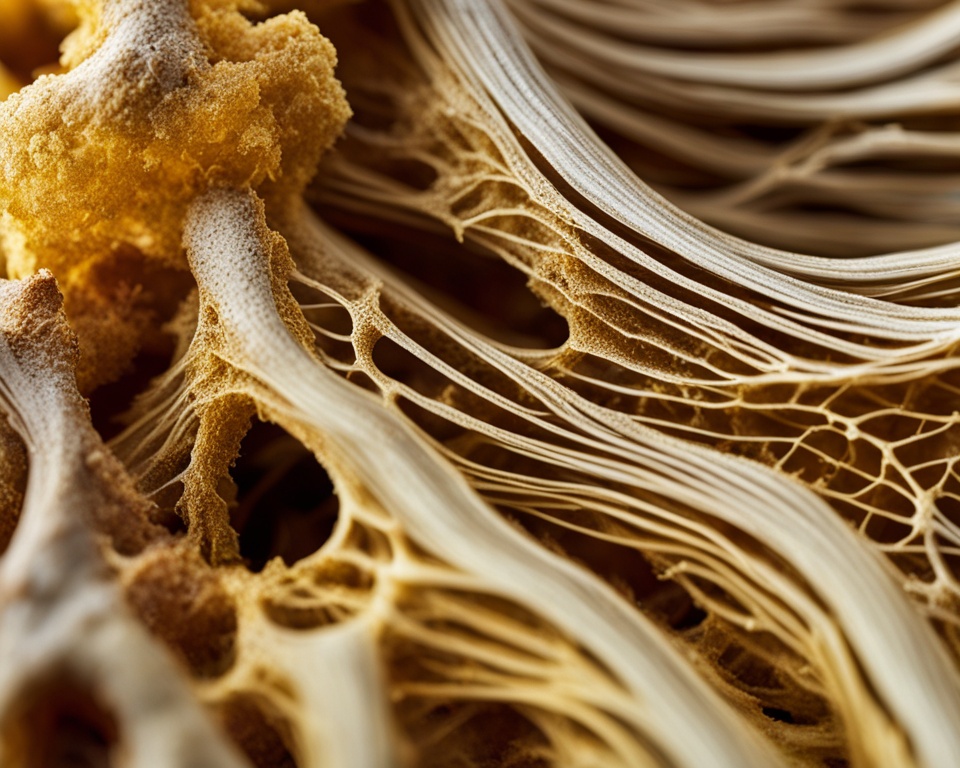
Conclusion
Zingiber officinale Roscoe, also known as ginger, has amazed people all over the world for hundreds of years. This guide has explored ginger’s scientific name, its plant features, and its chemical makeup. It also looked at how this spice is used in cooking and medicine.
Ginger has a rich history and many uses today. Its ability to reduce inflammation and act as an antioxidant makes it popular in many health remedies. It’s used in both savory and sweet dishes, and as a natural health aid.
As scientists learn more about ginger, its future looks bright. The ongoing research into ginger shows it could offer even more health benefits. Ginger’s long history proves that nature can provide us with foods that are good for our health and taste great.
